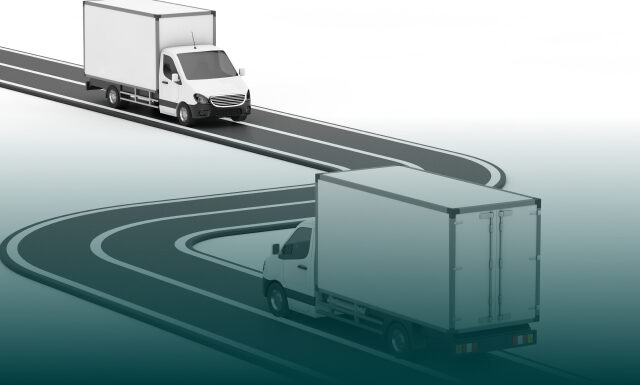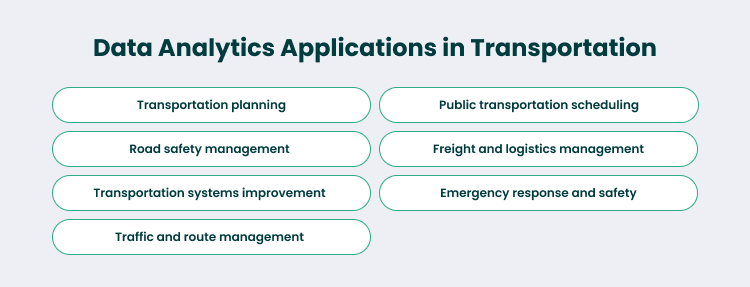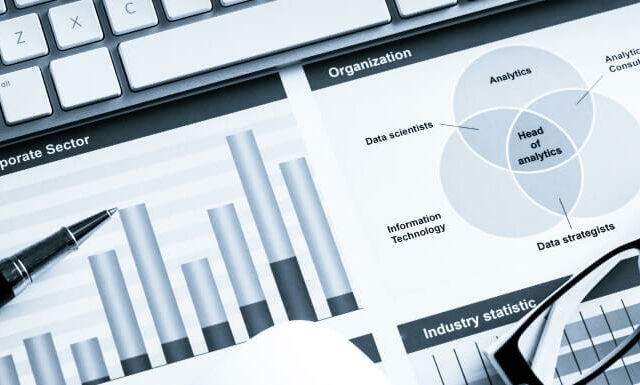The transportation industry constantly experiences tough challenges – rising fuel costs, unpredictable routes, delays, and fleet efficiency management, to name a few.
The average fuel cost per gallon for U.S. airlines is on the rise. Supply chain disruptions continue to impact the industry. This means businesses feel the pressure from the current market situation.
These roadblocks don’t just slow down operations; they affect profits, prices, and customer satisfaction.
But what if you could prevent and avoid these challenges before they become major issues? With transportation analytics, it’s possible.
Imagine having real-time insights that optimize routes, predict delays, cut fuel costs, and streamline the supply chain. From reducing vehicle downtime to improving delivery times, data-driven decisions can transform transportation.
Ready to reveal the power of data analytics in the transportation industry? Read this article to learn about its benefits and use cases and begin your journey toward more efficient solutions.
Why Are Businesses Turning to Transportation Analytics?
Today, in the transportation industry, efficiency, safety, and mobility cannot be achieved without innovation. It’s important to collect data and rely on it when making decisions. But only data analytics can ensure the proper processing of data and its use for informed decisions in transportation planning and optimization.
Let’s explore how transportation data analytics is being used today to help you understand how it can be applied to your business.
- Transportation planning: AI implementation in data analytics for transportation helps planners make smarter decisions by identifying the most relevant and actionable data. By leveraging AI, planners can analyze information from mobile signals, GPS trackers, and public transit systems to gain an accurate, real-time picture of traffic patterns and trends, enabling more effective route planning and resource allocation
- Road safety management: Transportation analytics can be used to analyze accidents and their details like place, time, and causes. With this data, it’s possible to create crash maps that show high-risk areas to warn about issues and encourage to be extra careful at certain locations.
- Transportation systems improvement: By integrating big data analytics into transportation systems, companies will make it better by creating a connected framework based on current and historical data. It gives them a complete view of data for planning.
- Traffic and route management: Predictive analytics does a good job handling traffic and routes. It considers various factors, including weather and other conditions to avoid traffic jams. As a result, such an approach allows for smoother traffic flow across all transport modes.
- Public transportation scheduling: Data analytics is also used to improve public transportation scheduling by matching bus or train times to when people need them most. This makes travel smoother for passengers and reduces costs.
- Freight and logistics management: Data analytics helps improve routes and schedules in freight and logistics. It reduces delivery times and boosts efficiency by predicting possible disruptions and adjusting to changes.
- Emergency response and safety: When it comes to emergency services, it’s necessary to analyze vehicle data very quickly. Real-time data helps speed up addressing issues related to safety and emergencies. As a result, this is a good way to make roads safer by monitoring and adjusting to traffic problems if they occur.
So see, the use of transportation data analytics makes it more efficient and advanced, especially in terms of planning, management, and decision-making.
Want to know more about how data analytics in transportation is being used today? Contact us to explore customized solutions for your business and start driving smarter results now!
How Businesses Can Grow from Data Analytics in Transportation
According to Precedence Research, the global freight transport market was valued at USD 34.53 billion in 2024 and is projected to reach approximately USD 100.81 billion by 2034, growing at a CAGR of 11.31% from 2025 to 2034. Sounds promising, right?
But with big data in transportation, companies will come to more advanced and sophisticated solutions that will boost this area. Thus, see what benefits you can get with data analytics:
- Transport flow analysis: By tracking the movement of products between locations and seeing how it affects operations, transportation insights can help reduce costs and improve services. That’s why for companies, this is a good way to map the movement of their products and timely address emerging issues.
- Efficient strategies: As supply chains become more complex and dependent on partnerships, transportation analytics can better visualize manufacturing and distribution needs to build more efficient strategies that will lead to informed decisions.
- Cost optimization: Transportation analytics provide a clear plan and help identify which processes and actions need to be fixed for cost and operational optimization. So, this is a good way to save costs and repurpose it for other objectives.
- Safety improvement: Companies use transport data to improve safety programs and schedule vehicle maintenance. It also helps identify and avoid dangerous routes, high-risk areas, and accident-prone roads.
- Enhanced customer experience: Transport historical data helps organizations enhance customer service. It provides insights that can improve response times and delivery speed.
- Better visibility of operations: Business intelligence and analytics in transportation give companies real-time insights into their operations. By leveraging BI tools, businesses can track shipments, identify potential issues or delays, and proactively manage logistics to prevent costly supply chain disruptions
All these benefits prove the power of transportation data analytics and encourage companies not to underestimate the value of information for creating strategies and making more informed decisions.
The Real Impact of Business Analytics on Transportation
Digital transformation has reshaped the transportation industry. Intelligent transportation systems and machine learning for transportation data are changing how people move, providing more efficient ways to handle logistics and traffic. Let’s look at real-world applications of business analytics in transportation.
Smart city traffic management systems
Smart cities use machine learning to analyze lots of traffic data and manage traffic in real-time. These systems track how many cars are on the road and when traffic gets heavy. This helps reduce traffic jams and makes commuting easier for everyone. Cities also see less pollution, and people spend less time traveling. Traffic data analysis is a key part of making this happen.
According to the latest report, the smart city market is projected to reach hundreds of billions of dollars by 2025, with annual spending on smart traffic management systems estimated to be nearly $23 billion. One of the reasons for this growth is technological integration with big data strategy, AI, and IoT used to enhance safety and optimize traffic flow.
Predictive analytics for railroad operations
Predictive analytics are a big deal for railways. They help trains run on time and stay safe by predicting issues before they happen. This allows railways to plan better and avoid problems. With machine learning, railways can improve maintenance, handle incidents faster, and run more trains smoothly. It’s all about being safer and more efficient.
Predictive analytics, powered by AI and machine learning can lead to significant cost savings. For example, it can result in a 15% increase in traffic flows and potential cost savings of up to $7 million. It means that railway companies can optimize and streamline operations with predictive analytics based on AI.
Data-driven airport logistics and scheduling
Big data is transforming how airports operate, making air travel smoother and more efficient. By analyzing vast amounts of data, airports can better manage flights, passengers, and resources. This leads to more on-time flights, efficient use of gates, and shorter wait times for travelers, ultimately improving the passenger experience.
Data-driven logistics also optimize baggage handling, fuel management, and crew scheduling, reducing delays and improving overall efficiency. GIS (Geographic Information Systems) technology plays a crucial role in planning airport expansions and managing runway operations, ensuring airports can grow smartly to meet future demands.
How to Get Started with Transportation Data Analysis
Starting a transportation project with big data analytics is exciting and offers many benefits. You need a plan to use technology and methods to improve transportation. Understanding how big data can enhance predictions is the first step toward making transportation more efficient and eco-friendly. So, here are our recommendations on how to get started with transportation data analysis:
First, assess your data needs and capabilities to know exactly what data is necessary for your project. Check out what’s important and see how it fits with what you can handle. Look into useful stuff like traffic patterns, traveler habits, and supply chain details. Don’t forget about data safety and privacy rules.
Second, choose the right big data tools that match your goals. For example, you may want algorithms to improve transportation or software for analyzing data. Each tool should help in a specific way, like speeding up processing, diving deeper into analysis, or making things easier to use, for making more informed decisions.
Third, build a skilled team for data analysis. Bring together people who are great at data analysis and have a solid grasp of transportation and how to use data insights to improve things in that area.
Fourth, team up with other companies for data sharing and collaboration. Working with others can greatly enhance your data analysis. Establish partnerships to share data and gain more valuable insights. These collaborations can help you dive deeper and come up with better plans for your transport project.
By following these key tips, you can make the most of big data in your transportation solution. This will set you up for smart planning and improved network performance.
Ready to transform your transportation projects with big data? Get in touch with us to see how we can help you get started with transportation data analysis.
Need Help with Integrating Data Analytics into Your Transportation Operations?
Integrating data analytics into your transportation operations requires robust expertise and various approaches to achieve better outcomes. At Forbytes, we’ve been working for over 12 years and have numerous successful projects in logistics and transportation. Your project could be our next success story.
Our team provides business intelligence and analytics services. We can design a custom BI solution and seamlessly integrate it into your infrastructure. With our expertise, you’ll have an all-in-one tool to automate reporting, visualize data, and drive predictable business growth.
So, whether you’re starting a new solution or want to fuel an existing one with transport analytics, contact us to make your transportation operations more advanced.












